Seaweed Blenny
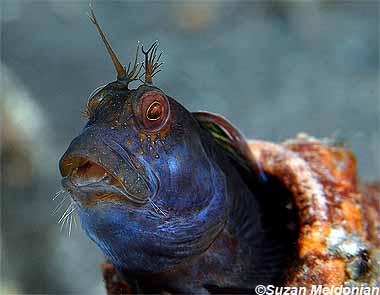
Parablennius marmoreus
This tiny fish rarely gets to be more than 3 inches long. Although it has a few look-alike fish, it is easily recognized by the tufts of branched cirri above each eye. Its elongated body with blunt head is ideal for life in the shallows among rocks, seaweed, and seafloor litter or mangrove roots. After mating, the male guards all of the eggs from his mutliple females until hatching.
Order: Perciformes
Family: Blennidae
Genus: Parablennius
Species: marmoreus
Common Names
Common names include seaweed blenny (English), blénido pintado (Spanish), and blenio marmoreo (Spanish).
Importance to Humans
This species is the only member of its genus that is often seen in the aquarium trade. If kept in captivity, it needs to be supplied with a good source of plant material such as microalgae to mimic its diet in the wild.
Conservation
> Check the status of the seaweed blenny at the IUCN website.
The IUCN is a global union of states, governmental agencies, and non-governmental organizations in a partnership that assesses the conservation status of species.
Geographical Distribution
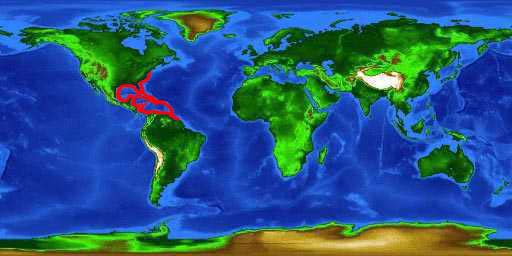
The seaweed blenny is distributed in the western Atlantic Ocean from New York (US), Bermuda, the Bahamas, and the Gulf of Mexico to southern Brazil.
Habitat
This small fish inhabits shallow waters to 32 feet (10 m) in depth. It resides in eroded basins and limestone boulders covered with a diverse assembly of algal mats, sea fans, and other marine invertebrate life. It is sometimes found among mangrove roots or associated with litter such as cans and bottles on the bottom. The young occasionally associate with floating sargassum.
Biology
Distinctive Features
As with all combtooth blennies, the seaweed blenny has an elongate body with a blunt head. There are several prominent cirri on each eye which are branched. The snout of this fish is blunt; the gill openings are continuous across the isthmus (fleshy throat region). The anterior naris (nostril) terminates as a short tube with a triangular flap while the posterior naris is a small pore with a margin that is slightly raised. The caudal fin is broadly rounded. The lateral line of the seaweed blenny extends from the upper opercular angle to near the end of the spinous section of the dorsal fin.
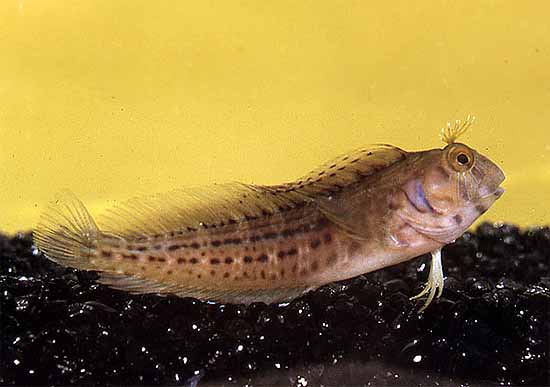
Closely related species that morphologically resemble the seaweed blenny include the pearl blenny (Entomacrodus nigricans) and the molly miner (Scartella cristata). The pearl blenny has a deeply notched dorsal fin with a low and straight-edged spinous section which distinguishes it from the seaweed blenny. The coloration of the pearl blenny also differs from the seaweed blenny – the body is brown with large dark brown irregular bars along with dark and white spots. Dark bands are also present on the lips and cheeks. The maximum size of the pearl blenny is slightly larger than the seaweed blenny at 10cm in length. The molly miner has a row of comb-like cirri down the central portion of the head, anterior to the dorsal fin which assists in the identification of this species. However it is similar to the seaweed blenny with branched cirri above each eye. The molly miner is olive brown with darker markings and a few white spots, along with a caudal fin that is usually barred.
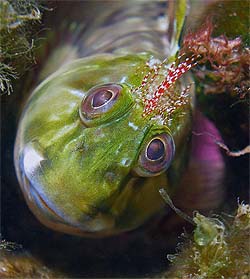
Coloration
The seaweed blenny has a tan to rusty orange, green or golden body with scattered or clustered dark brown spots that form lateral broken lines. There is a bronze region located on the top of the head. A dusky stripe extends from the eye toward the caudal fin on each side of the body which is most visible above the pectoral fin, fading toward the posterior of the body. In some specimens, there is a pale to bright blue spot on the fore-dorsal fin. The edge of the anal fin is pale. It is able to pale and darken it’s coloration as a camouflage response. The ventral surface of this blenny is whitish in color.
Dentition
There are 35-43 comb-like incisors in the jaws of the seaweed blenny. In addition, posterior canines are present in both jaws while the vomer lacks teeth.
Size, Age, and Growth
The maximum reported size of the seaweed blenny is 3.3 inches (8.5 cm) total length. Currently scientific data on maximum age and growth rates is not available.
Food Habits
As an omnivore, the seaweed blenny feeds primarily on algae along with some predation on polychaetes, crustaceans and hydroids. It uses its beak-like lower jaw to pick at prey items along the benthos and fouling communities. This fish is diurnal with active feeding and other behaviors taking place during the day.
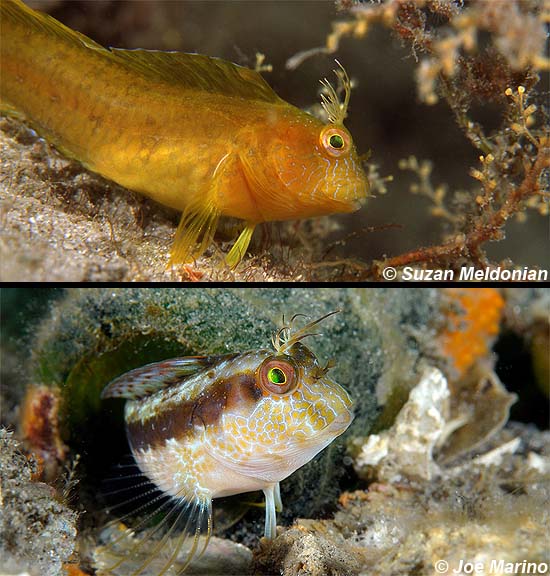
Reproduction
The seaweed blenny deposits eggs on the bottom substrate where after fertilization, the parental male guards the eggs of all of his female mates until hatching. This surface may consist of empty bivalve shells, holes and crevices in rocks, sponges, or inside discarded marine debris. Data on gestation period and the embryos of this species is lacking. It is known that the larvae range in size from 5.8-16.0 mm in length and have an average of nine teeth. The larvae settle onto the bottom substrate at lengths of 19.0-20.5 mm during which time they may have up to 22 teeth.
Predators
There is little information available on specific predators of the seaweed blenny, however it is most likely preyed upon by larger demersal fish and crustaceans including crabs and lobsters.
Taxonomy
The seaweed blenny was originally described as Blennius marmoreus by Poey in 1876; however this name was later changed to the currently valid Parablennius marmoreus (Poey 1876). The family Blennidae is a large group of fishes referred to as the combtooth blennies which are elongate, blunt headed fishes that often possess a long continuous dorsal fin and a fleshy crest on their heads. The genus name marmoreus is derived from Latin meaning “marble” perhaps referring to the coloration of this small fish.
Prepared by: Cathy Bester